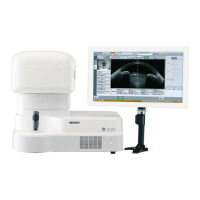
Do you have a question about the Tomey CASIA2 and is the answer not in the manual?
| Category | Medical Equipment |
|---|---|
| Model | CASIA2 |
| Manufacturer | Tomey |
| Wavelength | 840 nm |
| Axial Resolution | 10 μm |
| Transverse Resolution | 30 μm |
| Scanning Range (width) | 16 mm |
| Scan Depth | 6 mm |
| Power Requirements | 100-240 V AC, 50/60 Hz |
| Device Type | Anterior Segment OCT |
| Light Source | Superluminescent Diode |
| Measurement Items | Anterior chamber depth, angle, corneal thickness |
| Applications | refractive surgery planning |
Precautions against electric shock, fire, and explosion from installation and power connection.
Measures to prevent injury from instrument parts, modification, or improper handling.
Guidelines on correct instrument usage, liquid avoidance, and environmental conditions.
Provides an overview of the manual's structure and content organization.
Explains the meaning of various symbols used throughout the manual for safety.
Guidelines for safe and effective operation of the instrument.
Safety measures for instrument installation and power cord connection.
Checks and precautions to ensure safe operation before starting.
Safety measures during operation and after use of the instrument.
List of items in the package and definitions of technical terms.
General description of the instrument and its features.
Identification of main components, operator/patient interfaces, and ports.
Overview of screen configurations, indicators, and navigation between main screens.
Details on measurement, viewer, database, patient info, and system setup screens.
Instructions for joystick, touch controls, and identification of device symbols.
Safety precautions for instrument installation, connection, and setup.
Procedures for powering the instrument on and off.
Step-by-step guide for patient data entry, alignment, capture, and data saving.
Explanation of the Fourier domain method used for OCT measurements.
Details on the limited warranty and expected operational lifespan of the instrument.
Procedures for regular inspection and calibration checks for accuracy.
Guidelines for cleaning instrument surfaces and replacing consumables like fuses.
Instructions for proper storage and environmentally sound disposal of the instrument.
Initial steps and precautions for resolving common instrument issues.
Troubleshooting steps for power, display, error codes, and operational failures.
Procedure for extracting log data to aid in troubleshooting and support.
Information on ordering chin rest paper, fuses, and external HDDs.
Technical details on resolution, scan speed, power requirements, and dimensions.
Conditions for operation, storage, transport, and device classification.
Declaration of Conformity to EMC standards and a list of supported cables.
